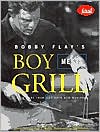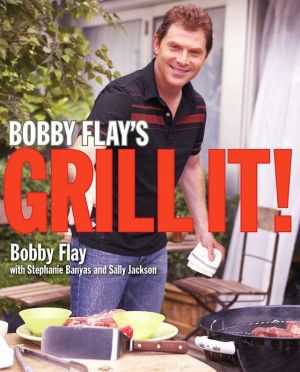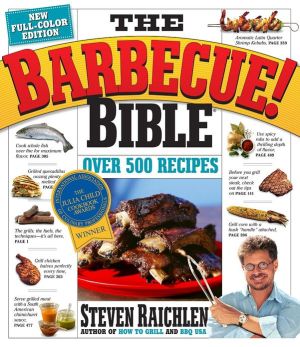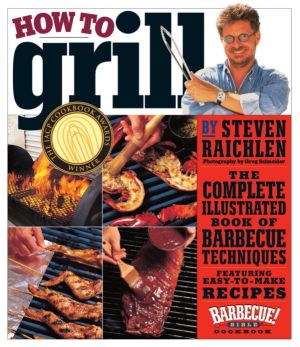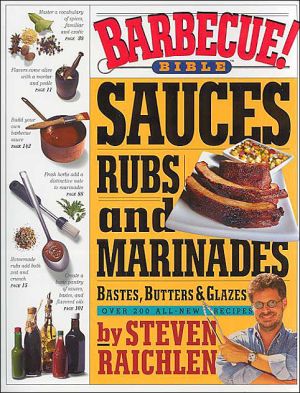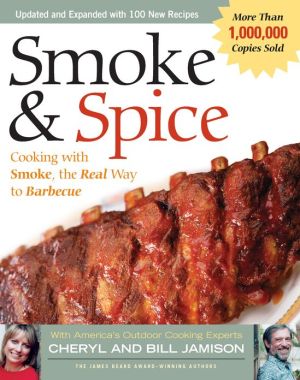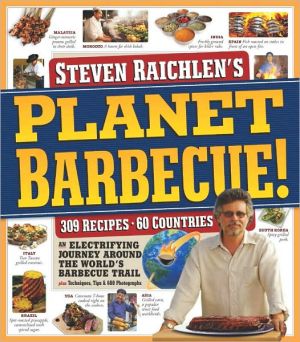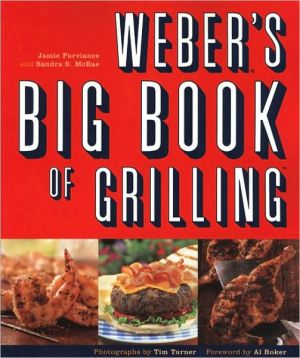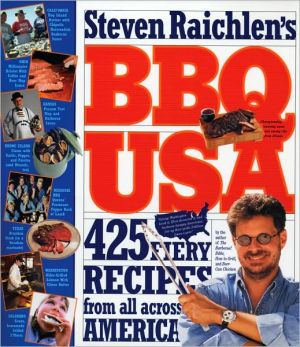Bobby Flay's Boy Meets Grill: With More than 125 Bold New Recipes
As the star of the popular Food Network programs "Boy Meets Grill," "BBQ with Bobby Flay," and "Iron Chef America," Bobby Flay helped turn the art of backyard barbecuing into more than a favorite summer pastime; he elevated it to the level of a national obsession.\ Bobby Flay's Boy Meets Grill is the book Bobby Flay was born to write. In these pages, he gets busy in his own backyard, cooking up a fresh batch of 125 bold new no-nonsense and easy-to-follow recipes for grilling mouthwatering...
Search in google:
The star of two cooking shows on the Television Food Network presents more than 125 recipes for mouthwatering meat, poultry, and fish dishes, as well as soups and salads that can be prepared partially or completely on the grill.
\ \ \ \ \ Chapter One\ \ \ A BOY'S INTRODUCTION TO THE GRILL\ \ \ Just mention grilling and the first thing I think of is hamburgers. There's absolutely nothing better than a great burger on the grill, seared dark brown and dripping savory juices, covered with melted cheese and grilled sweet onions. I like them a little more well done than most things I grill—probably because I loved those blackened hamburgers I ate at cookouts when I was a kid.\ Grilling has always appealed to the "boy" in me, and there's no way I would abandon the classic burgers I remember. But my menu has grown, and I like to slip in the unexpected, as well: clams or mussels steamed in a kettle set on the rack; an entire paella made on the grill; or a table filled with mountains of seared, golden vegetables. I still love to grill simple food, but I add a jolt of bold flavors with seasonings, marinades, and sauces.\ I do most of my outdoor cooking during the relaxed weekends I spend on Long Island. The beach, golf, and grilling make up my ritual—they are what life in the summer is all about. I love hitting the farmers' markets, picking up whatever is ripe and fresh, going home, and throwing it on the fire. The great thing is that you can get all this food at the peak of perfection and cook it immediately. I grill dinner almost every night that I'm out there, and often a simple lunch, too, like softshell crabs that I turn into a fabulous sandwich.\ My little daughter, Sophie, follows after me, usually with a bag of potato chips in her hand. She likes to help, or at least to hangaround while I'm cooking her favorite foods—grilled onions, corn, and lobster.\ With great ingredients tempting me on all sides, everything I put together on the grill works. In addition, I accumulate interesting spices and flavorings over the season and use them as the spirit moves me. By the time the summer is in full swing, my pantry will contain, in addition to pepper and kosher salt:\ vinegars, such as sherry, balsamic, rice wine, and red wine\ olive oil (I seldom use extra virgin; most of my recipes call for "olive oil" the stuff that used to be called "pure olive oil")\ chile powders such as ancho, pasilla, chile de arbol, and cascabel\ assorted mustards\ cumin\ cilantro\ paprika\ curry powder\ \ \ One thing I don't use is dried herbs—to me, they all taste like tea. (The only exception is in dry rubs, for crusting steaks or turkey.) Nothing beats fresh herbs, and they are easy to find at most greengrocers and even at supermarkets.\ I also make a few stocks the day I plan to cook with them, or else I keep them in the freezer, to be defrosted when needed. Chicken Stock enriches the Sherry Vinegar-Brown Sugar Barbecue Baste for chicken, the Honey Mustard Pan Juice for porterhouse steak, and the Charred Corn Polenta; Shrimp Stock adds flavor to Peanut Dipping Sauce for shrimp; and Vegetable Stock is the base for Grilled Asparagus Risotto. Recipes for these stocks appear at the end of this chapter.\ \ \ FUNDAMENTALS OF THE FIRE\ \ \ Don't be intimidated by the grill! It is a source of heat, just like a stove, and very user friendly.\ Grilling simply means cooking food quickly over a very hot fire. The food develops a seared, flavorful crust and a juicy interior, but you have to start out with tender meat, fish, or vegetables for this method to work. Grilling differs from barbecuing, which is slow cooking over a lower fire and is suitable for less tender foods.\ I'm devoted to my gas grill, but sometimes I also cook with charcoal, and there are a few things to remember in order to do it well. First, hardwood lump charcoal is considered to be better than the more easily available briquettes, because it burns hotter and cleaner. Use plenty of charcoal and light it with an electric coil starter or a chimney starter. The latter device is an open-ended cylinder into which you put crumpled newspaper, top it with charcoal, and light the newspaper. When the charcoal becomes hot, you pour it onto the grill and add additional charcoal on top. There also is a kettle grill that lights the charcoal using gas ignition.\ A two-level fire is recommended for cooking flexibility, and this can be constructed in different ways. Either light two piles of charcoal, one larger and one smaller; or light a large pile and after it is hot, move some of the coals off into a smaller pile.\ Some of my recipes require high heat, some medium high, and a few require low heat. If you aren't using a gas grill, which has a temperature gauge, measuring the temperature can be a little tricky. The tried and true way is to place your hand an inch or two above the hot charcoal. If you can keep it there for up to two seconds, the fire is hot; three to four seconds means medium hot, five to six indicates medium low to low.\ There is some controversy over whether it is better to cook with the grill lid closed or open. Advocates of charcoal grilling seem to prefer the flavor of uncovered food; gas-grill enthusiasts hold that food cooks more evenly and heat is retained better when the cover is down. As with most aspects of grilling, this comes down to personal taste. I always keep the cover down when I am preheating the grill, and I leave it that way through most of the cooking process, as well—otherwise the heat escapes. My general rule is, cook with the grill closed for anything that takes more than four minutes. I close the lid even for most of the quicker things.\ When people put something down on the grill, the tendency is to start moving it around immediately, so it won't stick. Actually, the opposite happens: if you move it too soon, it's bound to stick. When you put a piece of food on the grate, let it sit a couple of minutes so it starts to get a seared surface and grill marks. Then move it, if you have to—the seared crust will protect it.\ Food cooks quickly on the grill, and it's not difficult to measure doneness. I prefer to decide by appearance, and each recipe will tell you what to look for when you pull the food off the rack. It's a good idea to check while it is cooking, as well, by prodding it a little to judge its firmness (remember how it felt before you put it on the fire, and how it usually feels when it is sitting on your plate); or by cutting into it to see if the inside looks done. The United States Department of Agriculture is more specific and if you want to follow their rules, you will need an instant-read thermometer.\ \ \ CHOOSING A GRILL\ \ \ The first choice you make about buying a grill is charcoal or gas. (Electric grills, both outdoor and indoor, don't have the heat you need to grill well, so they aren't an option.) Both can give excellent results, so choose the one that best suits your style of cooking. Gas grills fire up much faster than charcoal, which is one reason I like them so much. My feeling is, now that we have the technology, we might as well use it, but that's strictly personal.\ The purist considers only charcoal grilling to be the real thing. There is a whole ritual about choosing the best charcoal, laying the fire and lighting it, and moving food around from hotter to cooler cooking areas. Charcoal provides an extremely hot fire, but it can be difficult to get lit, and then it takes about a half hour to reach cooking temperature, when it becomes covered with a film of gray ash. It can be hard to control the heat, to keep it even. True, charcoal does impart a certain distinctive flavor, although I find the real flavor boost comes from marinades and seasonings, and from quick searing directly over a very hot fire—which a good gas grill does as well as charcoal.\ If charcoal is your choice, you will find even the top grills are reasonably priced. Look for a sturdy grill with a cover and a large grilling surface, and, if possible, an adjustable grate and firebox. Weber kettle grills are among the most popular.\ A powerful gas grill provides strong heat and is far easier to light—just turn it on. It gives consistent temperatures, whether your food requires low heat or high, and temperature can be adjusted any time during cooking, so you don't have to move the food around. Because gas grills are easy to ignite and they get hot fast, you can spend your time preparing the food, not working on the fire—that's what I like to do. The simple start-up allows for real spontaneity: ten minutes after you make the decision to grill, you can throw the food on the fire.\ When shopping for a gas grill, look for one that heats up fast and is sturdy. A porcelain-coated grate will keep the food from sticking—the food comes away from the grill, and that's half the battle. The heat source may be lava rocks, ceramic briquettes, or metal plates or triangles. All are good, but the rocks and briquettes may need occasional cleaning and sometimes replacement. Some grills offer electric rotisseries and side burners as extra features. Among the popular manufacturers are Weber, Viking, Charbroil, and DCS, which manufactures grills for Williams Sonoma. Gas grills are more expensive than charcoal, starting at several hundred dollars and reaching to the stratosphere.\ If open-air grilling, either charcoal or gas, isn't an option, its principles can be applied using indoor equipment. A fireplace is the closest alternative, with the addition of a Tuscan grill, a metal frame that holds a grilling grate. Or you can set an ordinary grill rack on top of some bricks to raise the cooking surface above the flames. Keep the flue wide open, just as you must when you light an ordinary fire. Cooking may take a few minutes longer when you use a fireplace, since the food will not be covered.\ Some kitchen ranges come with gas grills, but not all provide enough heat to give good results, so check their specifications carefully. Again, you won't cover this grill, so you may need to cook food a little longer.\ Finally, consider using a heavy, ridged cast-iron grill pan, preferably seasoned, on your stovetop. Heat it for five to ten minutes before adding the food. You won't achieve optimum results, but you will reach a version of what we're trying to accomplish.\ \ \ GRILLING EQUIPMENT\ \ \ Forget the bells and whistles and keep your equipment simple—too many of the accessories you see hanging from hooks on fancy grills are not good for grilling. I prefer my regular kitchen tools to long-handled implements, which I find clumsy to use: I rely on a good, strong pair of tongs and a sturdy spatula that I'm really comfortable with. Don't forget a few heavy-duty potholders or mitts and a strong wire scraper to keep the grid clean. I would rather test food for doneness as it cooks than bother with a thermometer, but if you want to be extra sure when cooking a piece of meat, go ahead and use one. Grilling baskets and trays for vegetables prevent small pieces of food from falling through the grate, although food sometimes can steam rather than grill on them because there is less surface contact with the fire. For kebobs, I prefer bamboo skewers to the thicker metal ones simply because they leave smaller holes in the food.\ \ \ A WORD ABOUT QUESADILLAS\ \ \ Grilled foods and tortillas are a natural match, and one of the best ways to combine the two is in a quesadilla. The traditional quesadilla is a stuffed tortilla, more like a turnover. The tortilla is folded in half, covering its filling, and then fried in lots of hot oil. While the idea of a crisp tortilla shell enclosing a spicy, creamy, or chewy filling appeals to me, a turnover seems kind of a dull way to get there. And you can't heap very much filling on half a tortilla.\ That's why my quesadillas are stacked: each one has three tortillas separated by two layers of filling—a sort of club quesadilla. I thought these tortilla sandwiches would be a natural for outdoor cooking, and I was right. Over the fire, the tortillas soften a little, the cheese melts beautifully, and all the flavors in the filling—whether lobster and toasted garlic, prosciutto and mozzarella, or chicken and grilled tomatoes—are heightened by the smokiness of the grill.\ \ \ TIPS FOR GRILLING BOBBY'S WAY\ \ \ BEFORE GRILLING, LESS IS MORE. Simplicity is the whole thing in grilling, start to finish, and it's perfectly acceptable just to brush food with olive oil and sprinkle it with salt and pepper before putting it on the fire. Of course, you can play with ingredients a little beforehand too, using spice rubs and marinades, but don't overdo them or they will dominate the taste of the food. Save the real blast of flavor for later.\ \ \ AFTER GRILLING, PULL OUT ALL THE STOPS. Condiments make the dishes distinctive and more interesting than your nextdoor neighbor's barbecue. Be bold with your own fruit- and vegetable-based ketchups, relishes, and salsas that are spicy, tart, or sweet.\ \ \ DO WHAT WORKS. THE GRILL IS NOT SACRED. Certain foods, such as lobster and corn, will dry out if they are completely cooked on the grill, and some others, like potatoes, will take too long and throw your whole dinner off schedule. The solution here is to precook some food three-quarters of the way through, set it aside, and then throw it on the grill shortly before serving.\ \ \ The opposite works, too. You may plan to serve fish fillets or steaks, but you'd rather not grill them at the last minute. Can you give them the sear and flavor that only a grill can produce, and still do most of the work ahead of time? Yes, if you sear them on the grill, set them aside, and then finish their cooking in the oven when your guests arrive. This can be done with most fish and meat recipes.\ \ \ USE SQUEEZE BOTTLES. Pour vinaigrettes into squeeze bottles and store them in the refrigerator. They make for a very organized storage system, but even more important, they allow you to control the amount of dressing you put on your salads and other dishes. And it's fun to decorate your foods with swirls of the vinaigrettes.\ \ \ ORGANIZE! PRIORITIZE! Organize your tasks: plan a menu, make lists, do the shopping. Decide on priorities—know what you can make ahead, whether it's a day or a couple of hours. Plan what you're going to make first, second, and third, and stay in that order, so that by the time your guests come, you have very little left to do besides grilling.\ When it's time to hit the grill, get everything out in front of you. This is what chefs call raise en place: all the food, spices, and tools you're going to need should be within easy reach.\ \ \ The whole idea of grilling is to be casual and festive, so keep it simple. Even if you love to grill as much as I do, don't get carried away and make too much food. Make sure you have a nice array of things to put out, but don't turn the cooking into a burden.\ I don't know of any other style of cooking that so easily lends itself to relaxed good times. A meal that's prepared outdoors on the grill invites everyone to loosen up and enjoy the party. People gather around with their drinks, checking on the food and the fire, helping the chef, or just talking and laughing in anticipation of a great meal. All the food goes out on big platters and guests can simply dig in and help themselves. This is my kind of entertaining—give it a try.\ \ \ STOCKS\ \ \ Shrimp Stock\ \ \ MAKES 4 TO 5 CUPS\ \ \ 2 tablespoons olive oil\ 3 cups shells and tails from raw shrimp\ 1 large onion, coarsely chopped\ 1 small carrot, peeled and coarsely chopped\ 1 celery stalk, coarsely chopped\ 6 cups water\ 1 cup white wine\ 1 medium tomato, chopped, or 1/2 cup canned plum tomatoes\ 1 bay leaf\ \ \ \ In a large saucepan over high heat, heat the oil until almost smoking and cook the shrimp shells and tails, onion, carrot, and celery 5 minutes. Add the water, wine, tomato, and bay leaf. Reduce the heat to medium, partly cover, and simmer 40 minutes. Strain through cheesecloth or a fine strainer. May be refrigerated, covered, up to 2 days, or frozen.\ \ \ Vegetable Stock\ \ \ MAKES 10 CUPS\ \ \ 4 large carrots, peeled and coarsely chopped\ 2 large whole heads of garlic, unpeeled\ 3 onions, coarsely chopped\ 4 leeks (white and half the green), washed well and coarsely chopped\ 5 stalks celery, coarsely chopped\ 3 parsnips, peeled and coarsely chopped\ 6 sprigs thyme\ 8 sprigs flat-leaf parsley\ 3 bay leaves\ 1 1/2 tablespoons peppercorns\ 4 quarts water\ \ \ \ Place all the ingredients in a large stockpot and bring to a boil over medium-high heat. Reduce the heat to medium and simmer for 1 hour.\ Strain the stock and discard the vegetables. Return the stock to the stove and continue to cook over medium heat, uncovered, until reduced to 10 cups, about 1 hour. May be refrigerated up to 2 days, or frozen.\ \ \ Chicken Stock\ \ \ MAKES ABOUT 2 QUARTS\ \ \ 3 pounds chicken bones\ 3 medium celery stalks, coarsely chopped\ 3 medium carrots, peeled and coarsely chopped\ 1 large white onion, coarsely chopped\ 10 black peppercorns\ 1 bay leaf\ 12 parsley stems\ Cold water to cover\ \ \ \ Place the ingredients in a large pot over high heat and bring to a boil. Reduce the heat to low and simmer, uncovered, 2 hours, skimming as needed.\ Strain through a fine strainer and degrease. Discard the solids. May be refrigerated up to 2 days, or frozen.
1 A Boy's Introduction to the Grill1 2 Burgers, Sausages, and Their Accompaniments13 3 Chicken and Other Poultry39 4 Fins and Shells71 5 Beef, Lamb, Pork, and Ribs139 6 Vegetables183 7 Sweet Things233 8 Drinks253 9 Menus261 INDEX265
\ From Barnes & NobleThe Barnes & Noble Review\ I would guess that Bobby Flay is now one of America's best-known chefs from his stint on Lifetime Television's "The Main Ingredient," his wild-and-crazy-guy persona on the Food Network's "Grillin' and Chillin'," his two previous cookbooks, Bobby Flay's Bold American Food and Bobby Flay's From My Kitchen to Your Table , and his many appearances at food festivals around the country. Meeting him, you certainly get a sense of a young man who is passionate about what he does and about life in general. And I would guess that the title of his latest cookbook, Bobby Flay's Boy Meets Grill , must have evolved from experience with the more traditional "boy meets girl" — his charm and vitality absolutely invite a come-hither look from the opposite sex! \ I had thought that this most recent cookbook was tied to his television work, but Bobby told me that these were new recipes that evolved more from his restaurants and his personal life than from his television shows. "When I would make personal appearances or even in the restaurants, people would always ask which of my previous books had the most grilling recipes. Enough people asked that I thought it was time that I did a complete grilling book." "Is there really anything new to do on the grill?" I prodded. "Definitely," Bobby answered emphatically. "Some of the recipes in Boy Meets Grill are totally new to the grill. I have tried to keep them all very practical but interesting. I think that home grillers will find lots of flavor and variety along with my usual big, bold flavors."\ "Is there aparticulartechnique or style that you think will most interest home cooks?" I inquired. "My technique for spit roasting on the grill will, I believe, really revolutionize backyard cooking. I try to take grilling beyond the 'throw a steak on' method and give cooks new ideas and inspiration for using the grill." "Do you offer us more than just meat?" I asked. "Oh, yes," enthused Bobby, "I do vegetables, fish, game, poultry — anything you can roast or sear, I grill." For those of us who live in colder climates, I was silently wondering if we could take these recipes indoors to our stovetop grills when Bobby interjected: "And almost everything can be done indoors on those handy little stovetop grills."\ I always ask cookbook writers whom I am interviewing what they hope the reader/home cook will take away from their books, mainly because I find that their answers usually give some insight into who they are. When I posed this question to Bobby Flay, he gave an answer that I thought very much explained his personality. "I want home cooks to know that grilling is not just about hot dogs and hamburgers," he said. "It's really about entertaining and having fun. It is a way to get your family and guests involved in the meal. And you know what, it is the least intimidating way to cook, and the results are always simple and delicious."\ Could there be any better answer from a chef who is as well known for his youth, sense of fun, and enthusiastic support of big, bold American flavors as he is for his prowess in the kitchen? I can guarantee that as you get ready for warm-weather outdoor cooking and pick up Bobby Flay's Boy Meets Grill , you will want to add Flay's other books to your cookbook shelf. Broaden your approach to cooking, both indoors and out, and let him introduce big, bold flavor into your life. He sure does know how to have fun at the stove or on the grill!\ —Judith Choate\ \ \
